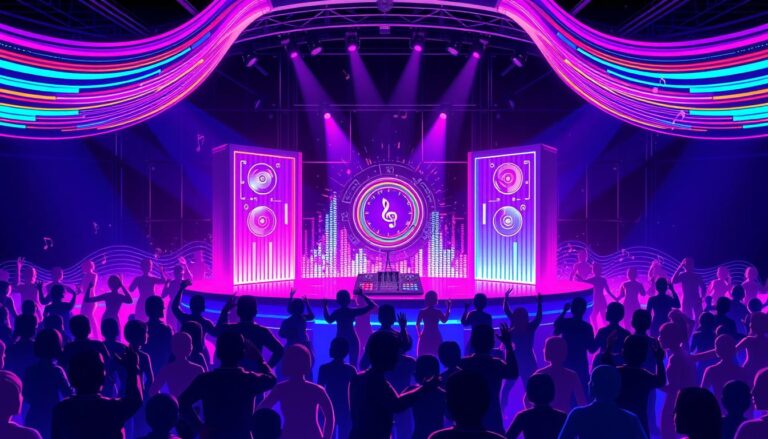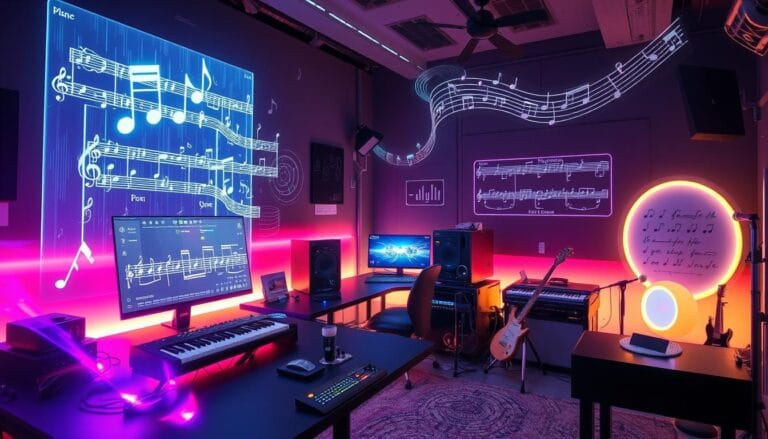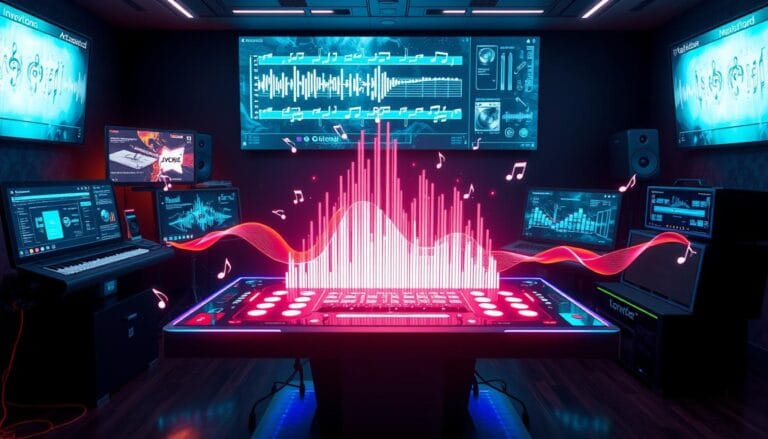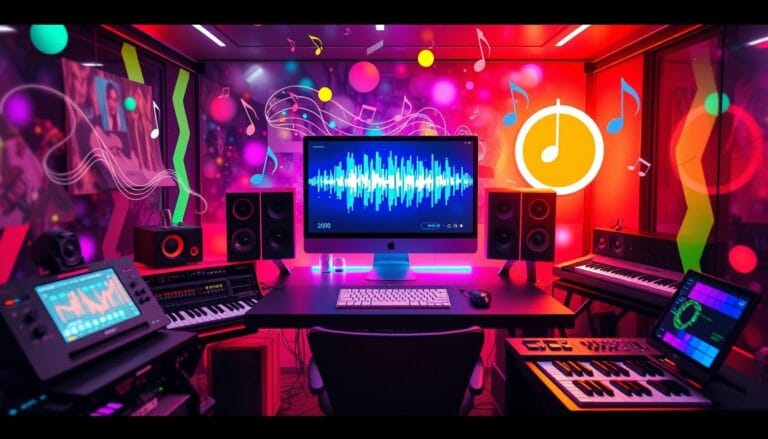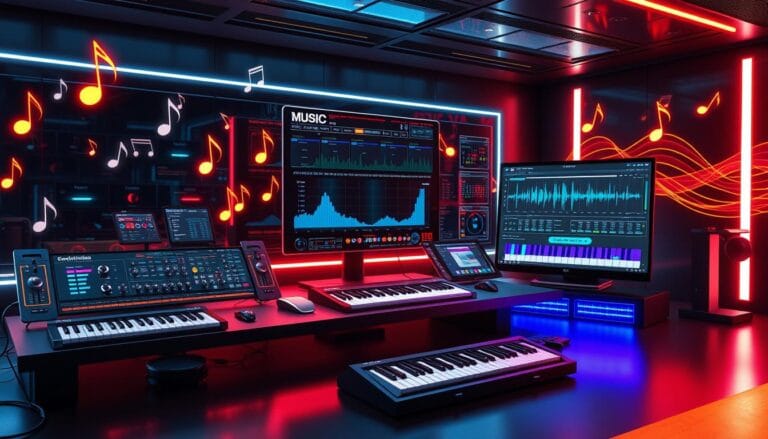Free Music Tools: Create Music and Sound Effects with AI Tools like Sonic Pi
Imagine a world where anyone can make music, not just the experts. A world where you can create amazing sounds that grab people’s attention. Suno, an AI music platform, is making this dream real.
I love how tech and creativity come together. Suno lets you use AI to tap into your musical side. It’s a place where your musical dreams can become a reality.
Table of Contents
Whether you’re a pro or just starting, Suno has what you need. It’s easy to use, powered by AI, and protects your work. So, start your musical journey with Suno and see what you can create.
Understanding AI-Powered Music Creation Tools
The music world has changed with AI tools. These tools use artificial intelligence to change how we make and enjoy music. They can create unique songs from just a few words.
How AI Technology Transforms Music Making
AI has opened new doors for music makers. AI music generators can make music fast, saving time and money. They can mix sounds in new ways, creating fresh styles for everyone.
Benefits of AI Music Generation
- Less money spent on musicians or studios
- Music is cheaper to make, with no licensing fees
- Quickly try out and improve ideas
- New sounds and styles are created
- More people can make music, not just experts
Current State of AI Music Technology
The AI music technology world is always getting better. It’s improving in voice creation, copyright, and working with traditional music. But, there are also challenges like copyright issues and the special touch of human musicians.
“AI-powered music creation tools are transforming the way we compose and experience music, opening doors to unprecedented levels of creativity and accessibility.”
The AI music creation market is growing fast. It’s expected to hit USD 38.7 billion by 2033. This will keep changing the music industry in big ways.
Getting Started with Sonic Pi and AI Music Generation
If you’re new to sonic pi coding for music, Sonic Pi is a great starting point. It’s free and open-source, letting you make music with code. It mixes programming skills with the creativity of sound design.
Sonic Pi is easy to use, making it perfect for both musicians and non-musicians. Learning Sonic Pi basics opens the door to combining coding and music. This is a powerful way to create.
Even though Sonic Pi isn’t AI-powered, it works well with AI music tools. Using AI for musical ideas, you can make unique songs and sounds. This opens up a world of creative possibilities.
To begin, get to know Sonic Pi’s features and coding language. Check out the tutorials and community resources to learn music programming basics. Once you know the basics, try adding AI-generated elements to your Sonic Pi projects. This way, you can mix human and machine creativity.
Whether you’re a pro musician or just starting, Sonic Pi and AI music generation are exciting. They offer a new way to explore and express music. Start exploring the endless possibilities of sonic pi coding for music and AI sound design.
Free Music Tools and AI-Powered Platforms
In the world of music, free AI tools and platforms are changing the game. They help poets and songwriters make tracks and sound effects. These tools can generate melodies and compose music in specific genres, making it easier to start your creative journey.
Popular AI Music Creation Platforms
Platforms like Amper Music, AIVA, Boomy, and Jukebox are leading the way. They use AI to create original music, letting users explore different genres and moods. Even though the free versions have limits, they’re a great way to begin with AI music.
Comparing Different Free Tools
When picking a free AI music tool, look at its features, ease of use, and sound quality. Some tools focus on loops or cinematic sounds, while others offer more. Finding the right tool for your needs can enhance your creativity.
Features and Limitations of Free Options
Free AI music tools have some limits, like restricted features or sound libraries. Yet, they’re a great chance to try AI music and see its potential. You can decide what’s important for you and maybe upgrade later if needed.
“These free AI music tools have been a game-changer for me. I’ve been able to create compelling soundtracks and sound effects that perfectly complement my poetry, all without breaking the bank.”
– Jane Doe, Poet
Creating Original Sound Effects Using AI Technology
In today’s digital world, unique sound effects are more important than ever. AI technology has become a key tool for creating original sounds. It helps audio experts and creators make their projects stand out.
ElevenLabs Sound Effects AI is a leading platform for sound effects. You just describe what you need, and it creates a realistic sound. Whether it’s footsteps in the snow or a futuristic gadget, ElevenLabs makes it easy.
Other tools like PopPop AI, MyEdit, ClipMove, and TopMediai are also changing the game. They offer features like easy interfaces and vast sound libraries. These tools help you create unique sounds quickly.
Using AI for sound effects saves time and opens up new creative paths. It’s great for professionals, creators, or hobbyists. AI tools help make your audio projects truly special.
To start using AI for sound effects, check out the many platforms available. By using AI, you can improve your audio work and explore new ideas.
| AI Sound Effect Generators | Key Features |
|---|---|
| ElevenLabs Sound Effects AI | Advanced text-to-speech, realistic voice synthesis, supports multiple languages |
| Boom Library AI | Vast sound libraries, AI-powered customization for pitch and tone |
| Soundraw | Focuses on custom soundtracks, intuitive editing and adjustment |
| Resemble AI | Text-to-audio conversion, seamless integration with editing software, voice cloning |
| AIVA Sounds | Text-to-sound capabilities, extensive pre-set sound libraries, user-friendly interface |
By using create sound effects with ai and ai sound design tools, you can boost your creativity. AI technology is a game-changer for audio production. It lets you create original sound effects that make your projects shine.
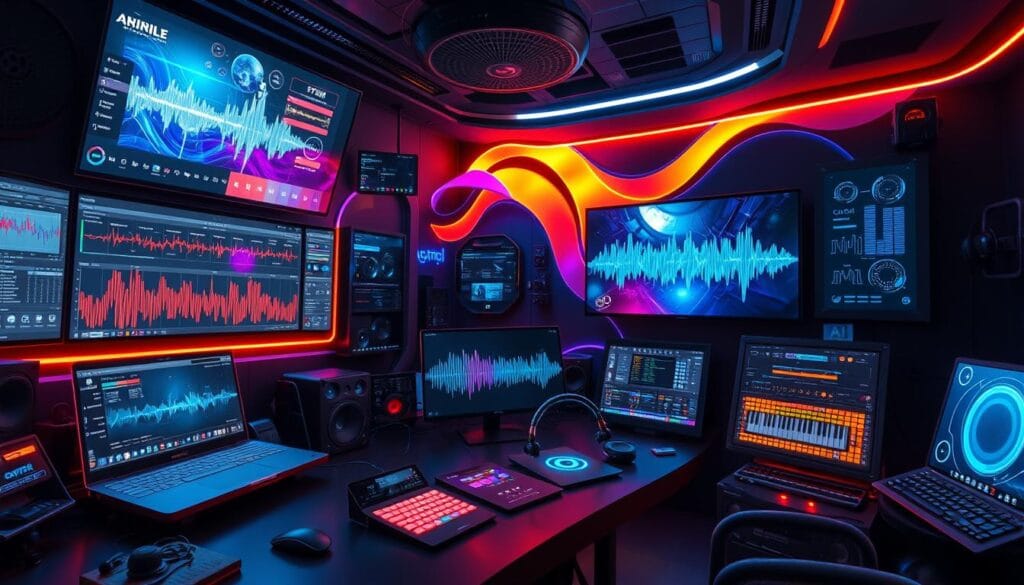
Mastering AI Music Composition Techniques
Making music with AI tools like ChatGPT is exciting. You can create complex melodies and sound effects. It’s a new way to express music, whether you’re experienced or just starting.
Basic Composition Methods
Begin with the basics of AI music making. Use AI to create rhythms, harmonies, and melodies. Then, add your own ideas to these AI-generated parts.
Advanced Sound Design Strategies
Explore advanced sound design with AI. Use AI tools to make unique sounds and textures. Learn how to manipulate audio signals for better soundscapes.
Working with AI-Generated Patterns
Working with AI patterns is fascinating. Use these patterns as a starting point for your music. Mix them with your ideas for something new and exciting.
When using how to make music with chatgpt and coding music with ai prompts, be open-minded. Let AI tools inspire you to create something unique.
“AI is not a replacement for human creativity, but rather an empowering tool that can expand the possibilities of music-making.”
Copyright and Legal Considerations for AI-Generated Music
The world of AI music creation is growing fast. It’s important to know about copyright laws and legal issues. Tools like Sonic Pi give musicians and creators new chances, but the legal side can be tough.
Copyright law often needs a human creator to protect a work. This makes AI music tricky to protect in many places. But, things get more complicated when humans use AI in their work.
- Some AI music sites, like Soundful, offer music for free. This lets users use the music without paying the creators.
- Licensing for AI music can change a lot. Some give more rights, while others limit how you can use the music.
- It’s key to follow each license’s rules, especially for business projects or videos on YouTube and Twitch.
The laws around AI content are changing fast. Cases like the 1988 Berne Convention and the Elvis Act are shaping the industry. They mix technology, creativity, and rights in new ways.
“Using AI music tools opens up new chances, but knowing the law is key. It helps everyone involved in music-making to stay safe and successful.”
Keeping up with copyright law and licensing is important. It lets creators use AI music confidently. They can explore new tech while protecting their and others’ rights.
Best Practices for AI Music Production
The world of ai music creation is growing fast. It’s key to learn how to use AI tools well in your music making. By making your workflow better, checking quality, and knowing how to share your music, you can make your music better than ever.
Workflow Optimization Tips
Here are some tips to make your ai music creation smoother:
- Make AI tools work well with your usual music software. This makes creating music easier and faster.
- Try out AI-made parts like drum beats, chords, and melodies. Mix them with your own ideas to make something new and exciting.
- Use AI for making new sounds. This can help you create music that sounds fresh and different.
Quality Control Measures
Keeping your music quality high is very important when using AI. Here are some steps to help:
- Check and adjust AI-made music to fit your taste and standards.
- Use AI parts and add your own touch to make the music sound complete and polished.
- Use tools like Izotope’s Neutron and Ozone to make your music sound even better.
Export and Distribution Guidelines
When sharing your AI-enhanced music, keep these tips in mind:
- Learn about the rules for using AI music. This makes sure you follow the law and respect others’ work.
- Look into platforms like LANDR’s Fair Trade AI Program. They help artists get fair pay for their music used in AI.
- Use tools like LANDR’s Selector to find the right samples and sounds for your music.
By following these ai music creation best practices, you can make the most of AI in music. This way, you can create music that is top-notch, fresh, and follows the rules, all while engaging your listeners.
Integration with Other Music Production Tools
In music creation, AI tools and traditional software are changing the game. They work together to make tracks sound polished and professional. This mix brings out the best in both worlds.
DAWs like Pro Tools, FL Studio, and Logic Pro X now work with AI tools. This lets you use AI’s unique features while keeping control over your music. You can mix and master your tracks with ease.
Working with AI lets you try out new patterns and melodies. Then, you can refine them with traditional music techniques. This mix of AI and human touch opens up new creative paths for all musicians.
| DAW | Key Features |
|---|---|
| Pro Tools | Industry standard for audio recording and editing |
| FL Studio | Highly popular among hip-hop and electronic music producers |
| Logic Pro X | Exclusively available on macOS, favored by professional producers and musicians |
| Ableton Live | Renowned for its innovative session view and real-time composition capabilities |
| Cubase | Known for its powerful MIDI capabilities and extensive plugin support, popular among composers and advanced producers |
| Reason Studios | Stands out with its virtual rack for sound design, attracting sound designers and experimental producers |
| Studio One | Offers drag-and-drop functionality and an integrated mastering suite, suitable for both beginners and professionals |
By combining AI tools with top DAWs, you can reach new heights in music production. This integration boosts creativity, efficiency, and quality in your work.
“AI-powered music production tools open up new avenues for indie artists, allowing them to create high-quality tracks without a massive budget or formal education.”
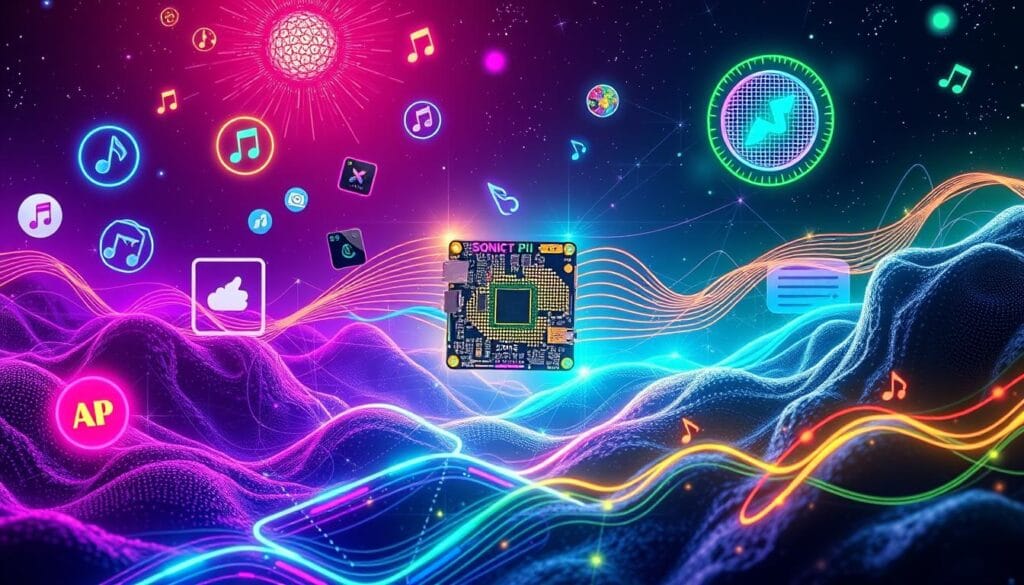
Conclusion
The world of AI music tools has opened up new possibilities for musicians and composers. Tools like Sonic Pi and many free platforms offer endless options. You can now create music tracks, sound effects, and explore AI-assisted composition.
As you explore this new world, remember to balance AI with your creativity. These tools can help you work faster and spark new ideas. But, always keep your artistic vision in mind and think about the legal side of AI-generated content.
The future of AI in music looks bright. It will make creating music easier and more accessible. Use this chance to explore new sounds and shape the music industry’s future. With free tools and your imagination, you can make music that touches people all over the world.
FAQ
What are the benefits of using AI-powered music creation tools?
What is the current state of AI music technology?
How can Sonic Pi be used with AI music generation techniques?
What are some popular free AI-powered music creation platforms?
How can AI technology be used to create original sound effects?
What are the basic and advanced AI music composition techniques?
What are the copyright implications of using AI-generated music?
What are the best practices for AI music production?
How can AI music creation tools be integrated with traditional music production software?
Source Links
- Sonic Pi Official Documentation: Comprehensive guides and tutorials on using Sonic Pi for music creation. Available at sonic-pi.net.
- Sonic Pi GitHub Wiki: Detailed “Getting Started” instructions and troubleshooting tips. Access at GitHub Wiki.
- OpenAI API Documentation: Explore OpenAI’s API capabilities for creative AI applications at OpenAI API Documentation.
- GitHub Copilot: Learn how to use GitHub Copilot for AI-powered code generation at GitHub Copilot.
- GitHub Copilot Documentation: Access comprehensive documentation for GitHub Copilot at GitHub Copilot Docs.


